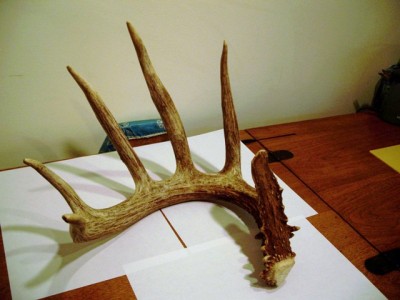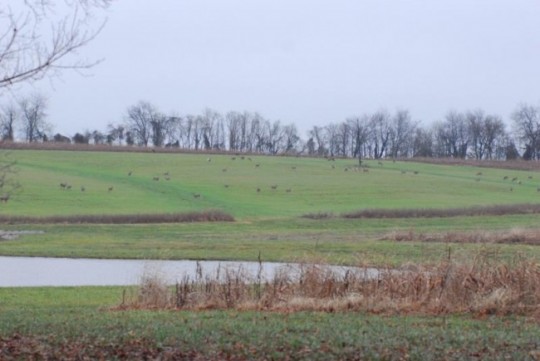Category: Hunting Blog
Pt. 4: Top 10 Recommendations for Managing Land to Yield Mature, Huntable Deer
Part 4: Adult Sex Ratio
In this blog I’ve been addressing a question posted on my Facebook page. The question was “What are your top 10 recommendations for managing land to yield mature, huntable deer?” During recent blogs, I’ve described the importance of age, nutrition, and cover in managing land to yield mature, huntable bucks.
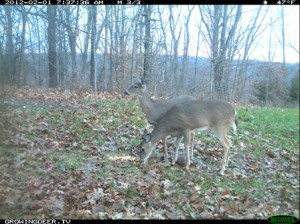
Two does
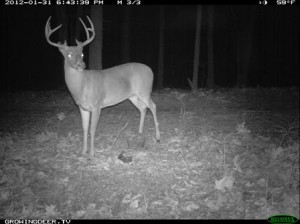
Buck near a Trophy Rock
If you’ve read those blog entries, it is obvious that reducing stress is a common theme to achieve the goal of managing for mature, huntable bucks. An equally important herd characteristic that should be managed is the adult sex ratio. The adult sex ratio is simply the number of bucks to does that are at least 1.5 years old. If a herd was composed of five bucks and ten does that were 1.5 years old or older, that herd’s adult sex ratio would be 1:2.
The adult sex ratio has several implications on the herd’s health and huntability, especially for mature bucks. It is common for a buck to attempt to tend a doe before she is receptive and remain near her for 24-48 hours. While he is “tending” that doe, other does may also be receptive. In fact, if the herd’s adult sex ratio is skewed heavily toward does, some does may cycle through their receptive period without being bred.
This results in them becoming receptive again about a month later. When this occurs, it means she will produce fawns a month later (or more if she cycles multiple times). This results in fawns being born later when conditions for fawning are probably not as favorable. As the summer progresses forage quality tends to decrease, insect loads become higher, the temperatures become higher, etc. Simply stated the conditions for prospering as a fawn tend to decline as the summer progresses.
Deer probably won’t express their full potential as an adult if they didn’t have all the required resources as a fawn. In addition to providing good quality forage (nutrition) and cover, it is just as important to ensure the adult sex ratio is balanced so the majority of fawns will be born during the optimal time for growth and reduced stress.
The older age classes also benefit from being part of a herd with a balanced adult sex ratio. It is very stressful for mature bucks to participate in the rut. Captive bucks in relatively small enclosures (less than five acres) and that have access to all the supplemental feeds they can consume have been reported to lose +/- 30% of their body weight during the rut. Given this, imagine the cost of participating in the rut for free-ranging wild bucks that must search for quality food, be constantly alert for two and four legged predators, and face all the daily challenges that captive deer avoid. In addition to the challenges of surviving, if a buck is part of herd where the adult sex ratio strongly favors does, the duration that he will seek, chase, and tend does is greatly extended simply because some does will not be bred during their first receptive cycle.
Likewise yearling bucks that are not fully mature will seek, chase, and tend receptive does as mature bucks are occupied with other receptive does. Yearling bucks would most likely develop better if they were dissuaded from chasing does by the presence of mature bucks (and their pheromones). Immature bucks need a huge amount of resources simply to maintain skeletal and body growth. The resources expended by participating in the rut may well limit the resources available for skeletal and body growth.
Likewise, it takes resources for does to cycle through her receptive period multiple times and nurture a fawn or fawns past the prime fawn rearing season.
Bucks, does, and fawns simply do best when they are born and rut during a natural timeframe and cycle. The best tool to ensure your herd is breeding and fawning at the optimal times is to manage the herd for a balanced adult sex ratio and ensure the population doesn’t exceed the habitat’s ability to supply quality forage.
In addition to a healthier herd, another huge benefit to managing for a balanced adult sex ratio is that that competition for breeding will likely be more intense and therefore bucks may be more active and most likely hunting strategies such as calling, rattling, using decoys, etc. may be more effective than in herds where there is not as much competition during the rut.
A great tool to manage your land to yield mature, huntable bucks is to establish and maintain a herd with a balanced adult sex ratio.
Growing Deer together,
Grant
Pt. 3: Top 10 Recommendations for Managing Land to Yield Mature, Huntable Deer
Part 3: Cover
During the past two weeks I’ve been addressing a question posted on my Facebook page. In those blogs, I discussed the importance of age and nutrition in managing land to yield mature, huntable bucks.
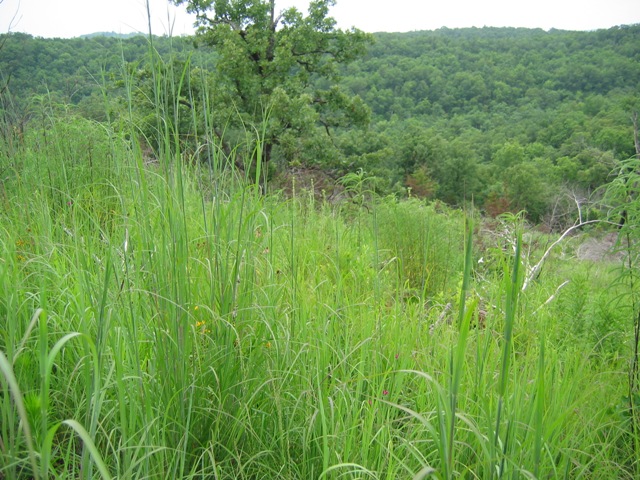
Area of cover for white tail deer
Next on my list of top 10 recommendations for managing land to yield mature, huntable whitetails is the need for cover. I define cover as areas where deer are likely to feel more secure compared to surrounding areas. In the Deep South cover may be shade, or in a colder climate native grass that serves to block the wind but allow the sun’s radiant energy to reach the deer. Cover may be areas where predator populations such as coyotes are reduced to be in balance with prey species.
Quality cover serves to reduce stress levels of deer and therefore allows them to express more of their antler growth and fawn producing potential. Cover can be just as beneficial to a deer herd as quality nutrition, depending on the sources of stress. However, one without the other means the deer herd likely won’t express its potential.
The best cover is not only a particular type of structure (shade, native grass, etc.), but also an area of reduced predation. Hunters are predators. To maximize the reduction of the level of stress it is best to combine the structure of cover while also making it a sanctuary (prohibit entry by humans during most of the year).
Sanctuaries are the least expensive form of cover to create. It simply means not entering an area. Sanctuaries with desirable cover are very beneficial to deer. To benefit the deer herd where you hunt, don’t just think about ways to attract them and make the deer easier to see, but think about managing enough of the habitat to insure each deer has a place where they believe they won’t be seen. This is not a totally unselfish act by hunters. Sanctuaries should result in a healthier herd, and one that is easier to hunt as deer that feel secure are not as alert.
My third recommendation for managing land to yield mature, huntable bucks is to create areas where they are “un-huntable” – create some sanctuaries!
Growing Deer together!
Grant
Pt. 2: Top 10 Recommendations for Managing Land to Yield Mature, Huntable Deer
Part 2: Nutrition
Last week I started addressing a question posted on my Facebook page about how to manage land to yield mature, huntable deer. The subject of that blog was how important age is to allowing bucks to express their antler growth potential. In addition, by allowing more bucks to mature, there will be more bucks to harvest – more bucks usually equates to better hunting.
However, there are lots of areas with a relatively high density of mature bucks, but very few bucks with good antler development. This often occurs in areas where hunting is not allowed and no habitat management activities occur. These areas include preserves, parks, etc. For bucks to express their genetic antler development potential, they must be allowed to 1) mature, 2) and have access to quality forage.
I remember visiting years ago with a wise gentleman when another person entered the conversation and shared an image of a very large buck recently harvested for that area. My friend instantly said “I bet that buck was harvested within a mile of one of the few soybean fields.” The gent with the image said “how’d you know?” My friend simply said, “All the big deer killed in this county are harvested by the soybean fields.”
My friend knew that big bucks are usually seen where the combines roam. His statement was not only correct for that county, but throughout the whitetails’ range. Compare the following maps. The first shows the distribution of soybeans grown throughout the continental states and the second shows the distribution of B&C and P&Y bucks harvested up to 2005. The correlation is not perfect, but it’s close enough to make the point.
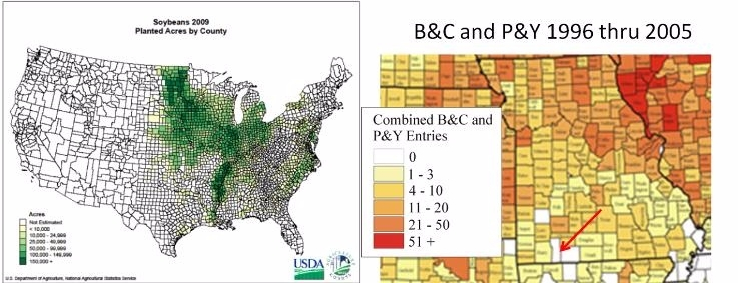
Planted soybean acres by county compared to big bucks by county.
The good news is that soil can be improved anywhere – even if the land you hunt is not shaded green on the soybean map. Notice that it’s a long way to any green on the map from where I live (Stone and Taney counties, MO). Even so, I grow great soybeans (and deer) using the combination of Eagle Seed beans, Antler Dirt fertilizer, and no-till drill techniques.
To have huntable mature bucks requires allowing bucks to mature and have access to good forage so they can express their antler growth potential. Good forage serves two purposes of allowing deer to express their potential and serving as an attractant so mature bucks can be patterned.
Insuring quality forage is available year round is #2 on my top 10 list of managing land to yield mature, huntable bucks.
Growing Deer together,
Grant
Pt. 1: Top 10 Recommendations for Managing Land to Yield Mature, Huntable Deer
Part 1: Age
Earlier this week I received a very good question on my Facebook page. Dan Dealy asked “Dr. Woods, what are your TOP TEN recommendations for managing land (and wildlife) to yield mature, huntable deer?”
One of the keys to Dan’s question was the second to last word –“huntable.” Most managers and hunters consider food, cover, and water, but they don’t consider how to make a property “huntable” or hunter friendly for mature bucks.
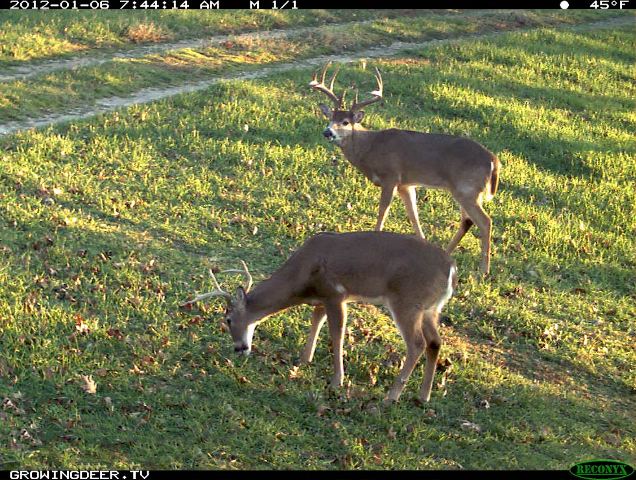
Last Lick Big 10 and Pumpkin Face
For a property to be huntable for mature bucks – for a hunter to have better than average odds of harvesting a mature buck – there are several factors that must be considered. To discuss all of these in detail would require a book (like Deer Management 101). In my next few blog posts, I will share some thoughts about my top ten recommendations to produce a huntable population of mature bucks. I apply these strategies and techniques to my property and have applied them to those of my clients for 20+ years. They are not deep secrets or magic recipes. They are proven and practical.
Having realistic expectations is the first step to satisfaction. It is important to understand that having huntable mature bucks doesn’t mean there will be Boone and Crocket class bucks behind every tree. A buck is mature to me when they are 4 years old or older. This is when bucks grow the largest antlers because most of their skeletal development is complete and they can use most of their excess resources to produce the biggest antlers of their genetic potential. Few free-ranging bucks express their genetic potential. In my opinion, many hunters, writers, etc., waste way too much time talking about whitetail genetics.
First, it’s very difficult to alter the gene pool of a free-ranging herd of whitetails. Second, there is probably nothing wrong with the genetics, but ample room for improvement of the habitat and herd structure.
With that said, my number one factor to improve the yield of huntable mature bucks is to have more mature bucks. To get more mature bucks, immature bucks must be passed and allowed to grow. Rule #1 the in Woods’ Book of Deer Management is that “Dead Deer Don’t Grow.” It sounds simple, but some hunters still don’t understand. They harvest a good looking two year old buck and then complain that they never harvest a “monster buck.” They’ve probably harvested several monster bucks – they just shot them before they matured and were allowed to express their genetic potential to produce large antlers! Bucks typically produce larger antlers as they age. University research shows that two and three year old bucks produce on average about 50 and 75% of their antler growth potential. It’s not until bucks mature to four years old that they express, on average, about 94% of their antler growth potential. To have an opportunity to harvest mature bucks, you must hunt where bucks are allowed to mature. That’s #1 in my top 10 recommendations for managing land to produce huntable mature bucks. The more bucks that are allowed to live to 4+ years of age, the easier it will be to harvest a mature buck. I’d much rather hunt a property that has three mature bucks per square mile than one or no mature bucks per square mile.
The least expensive form of deer management is trigger finger management. It simply costs less to pass immature bucks than any other form of management for establishing a hunter friendly population of mature bucks.
During 2012 – if you want to tag a mature buck, be prepared to pass immature bucks. Yes, others in your area may kill immature bucks. However, the trend must start somewhere and it is most likely to start with you. Share the education with other hunters in your area. You don’t have to convince all of them, but you won’t convince any of them when gathered around an immature buck you just harvested.
Remember, the first rule of deer management – “Dead Deer Don’t Grow.”
Growing (huntable mature bucks) Deer together,
Grant
When Bucks Grow the Largest Antlers
Ben Hampton, Prostaff on Midwest Whitetail, recently shared the pictures of this super buck with me. He found the buck’s sheds last year and they grossed 154 4/8 (172 4/8 with an 18′ spread) as a typical 6×6 and this year he grossed 174 3/8 as a 6×5, with an additional 10 non-typical points he didn’t have last year, for a total gross non-typical score of 191 6/8. Ben asked me if it was typical for a deer to make this big of jump between 5 and 6 and if the bad drought they experienced in the summer of 2010 could have suppressed last year’s rack.
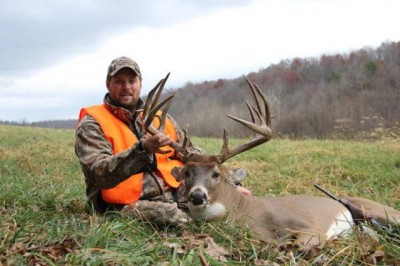
21 point buck harvested by Ben Hampton
Bucks, just like humans, are individuals. Some bucks produce larger antlers earlier than others. I was the tallest kid in 1st grade. Folks wanted me on their basketball team. By the time I was in high school, I didn’t make the team. Some bucks grow early, some mature late.
On average (averages represent populations – but almost never an individual) bucks express 94% of their antler growth potential by age 4.5. However, most wild deer don’t have access to quality forage year round. There have been bucks in research locations that barely scored 120 and then blew up to 200+ once given a better diet.
By being allowed to mature and having access to better forage created a perfect scenario for the buck Ben harvested to express his full antler potential. His timing was perfect.
So – in general, the better the year round forage, the later in life bucks will express their full antler growth potential.
Congratulations Ben, that’s a fabulous buck!
Growing Deer together,
Grant
How Weather Conditions Affect Hunting
It’s warmer than normal across most of the whitetails’ range. Warm weather during January is usually associated with swirling winds. Looking at the weather forecast below, the wind direction will go around the compass during the next day or so at my place. That makes hunting conditions tough.
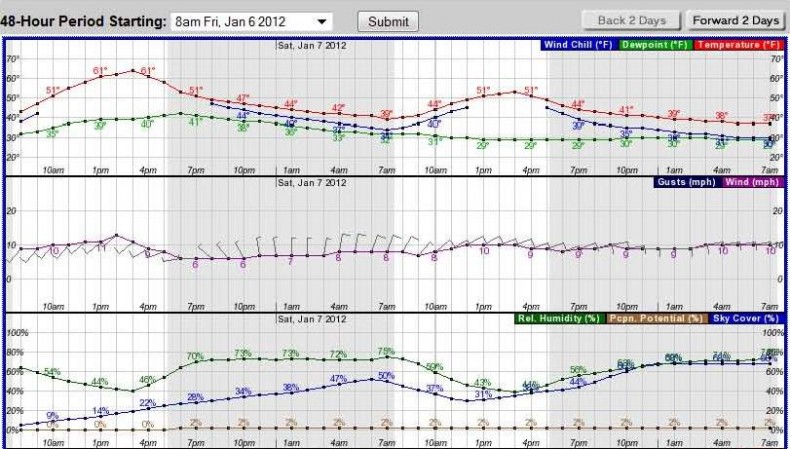
Hourly temperature prediction chart
However, that’s not the only ramification of warmer than normal temperatures this time of year to a deer hunter and manager. At this point in the season deer have a full fur coat. It was created to retain heat during extremely cold conditions for the area where those deer live (this is one reason deer shouldn’t be transported to new areas with different climatic conditions as they may not be adapted to thrive in the different conditions).
I don’t feel like moving much when I’m hot. Likewise, deer tend to limit their activity until the coolest times of the day when it’s hot relative to the normal conditions (60 in January when deer have a great fur coat probably makes them feel much hotter than when it’s 90 in July when they have a very thin summer coat). The coolest temperatures usually occur during nighttime. Hot temperatures during the late season encourage nocturnal activity. These factors make hunting deer very difficult during the late season when the temperatures are much warmer than normal for that time of year.
However, there are other considerations about warmer than normal temperatures during the winter. Deer ingest more food when they are colder – at least to a certain point. An exception is that if the temperatures get significantly colder than normal, deer tend to remain in cover and limit their activity.
Deer will produce larger antlers the following year if they consume more quality food (within limits) during the winter. It seems that warmer than normal temperatures probably result in deer consuming less food, and therefore potentially smaller antlers the following year.
I enjoyed walking to my stand yesterday without carrying bulky clothing. I never felt a chill the entire evening. Although I was comfortable, I would have gladly traded my comfort for colder temperatures and seeing deer during that hunt, and the hope of the local herd producing larger antlers and healthier fawns during 2012.
Slightly colder than normal temperatures during the late season probably result in better hunting, and healthier deer the following year. How are the weather conditions where you are hunting?
Growing Deer together,
Grant
Bucks Shedding Antlers Early
Adam called me two days ago with a bitter sweet message. He had found a shed from Giant 8. It was bitter because I had used some Reconyx cameras to understand Giant 8’s post late season feeding pattern. I had a Muddy hung, and felt I could tag him when the temperatures dropped and he needed to feed more during the daylight to gain calories to maintain his body weight. That plan is now canceled.
The sweet part is that his shed was found in one of two food plots that I had determined where Giant 8 was feeding. My scouting was spot-on! In addition, I’d rather the shed be found and confirmed it was a clean shed (no sign of injury, brain abscess, etc.) than he simply disappear.
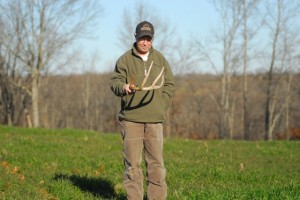
- Grant holding shed from Giant 8
I host an annual shed hunt during March. Even though March is relatively late for many shed hunters, we always jump a buck or two that still has antlers. However, I have multiple images of bucks that have shed early this year. In addition, folks from throughout the whitetail’s range have commented on my Facebook page about bucks shedding early in their neighborhood.
I expected bucks to shed earlier than normal this year – but not this early. Bucks will shed early when they are stressed. It was the fourth driest summer on record where I live. In addition to the lack of moisture, several months were recorded as the hottest or some of the hottest on record. Those hot and dry conditions caused a huge amount of stress to Eagle Seed beans planted in my plots. I was shocked they grew as well as they did – my other crops perished.
To a deer manager, forage plants are simply nutrient transfer agents. They simply transfer nutrients from the soil and air to the consumer (deer). No matter how many nutrients are available, plants can’t transfer nutrients without water. Soil moisture was so limited this year that the plants simply couldn’t transfer many nutrients. The heat directly and indirectly caused a huge amount of stress to bucks in my area this year.
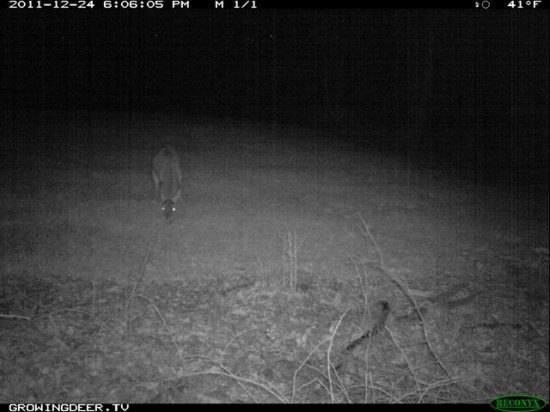
Giant 8 after he shed his antlers
I was shocked that the antler production was as good as it was during 2011. This was confirmed by comparing some sheds we found last year to some mature bucks that were harvested here this year (most notably Giant 10). I was pleasantly surprised that they actually produced larger antlers than during the previous year when the growing conditions were much better! This is a great testimony of the relationship between age and antler development. If you wish to harvest bucks with larger antlers, allow the bucks where you hunt to mature and provide the best nutrition you can afford. Food plots are relatively easy to produce and can definitely yield great results in allowing bucks to be healthier (larger antlers) and easier to hunt.
However, a buck’s antler growth potential (genetic potential) can only be expressed if the buck is allowed to live until it reaches older age classes AND has access to quality nutrition year round. It seems my buck hunting may be over soon even though the legal season where I live extends to January 15th. I learned some very valuable lessons about managing for and hunting mature bucks during the drought of 2011. I’ll be a better manager during 2012. I will continue sharing what I learned in this blog and each week in the video episodes of http://www.GrowingDeer.tv. Thank you for being part of the http://www.GrowingDeer.tv team and for sharing what you’ve learned and observed with us. May you be blessed with a great 2012.
Growing Deer together,
Grant
Predators and Prey
I posted an image on Facebook of Matt, my intern, with a bobcat he’d trapped this week. I was surprised that image resulted in name calling and arguing among readers of that page. Folks were either thrilled with the removal of a predator or offended that someone would trap a predator.
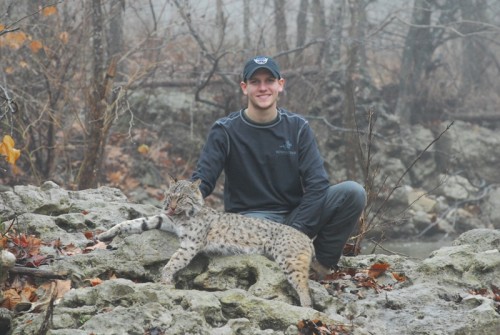
Bobcat that was trapped to help balance predator & prey species.
I trap and call predators for many reasons. I enjoy the challenge of matching skills with a predator. My family and I really like the pelts and we enjoy giving them as gifts. Just as importantly, I wish to attempt to balance the predator/prey relationship on my land so there are plenty of prey (turkey and venison) for my family, our guests, and for the remaining predators to eat.
When I was a younger boy (I’m 50 now), raccoon hides sold for $40+ in my neighborhood and gas was $0.70 per gallon. Now raccoons bring less than $10 in the same area and gas is $3.00 per gallon. We all know the price of fuel, steel, etc., has increased dramatically. There is very little incentive for trappers, except for the love of the work, to remove predators. Predator species have few predators in most areas.
“Balance” is a tough objective to achieve in most aspects of wildlife management. This is because the habitat and populations are always changing. It is a fantasy that wildlife populations or habitat will remain balanced without man’s intervention. Allowing either predator or prey species to build up too high always results in bad results. This has been documented time and time again in species like deer, rabbits, wolves, etc.
However, given that the habitat resources are becoming more and more limited, big swings in population levels don’t recover as easily. I don’t wish for predators – bobcats, opossomus, fox, raccoons, coyotes – to remove most of the prey species -turkey poults, and whitetail fawns – at my farm. I want there to be enough turkey and whitetails for me and the predators. There aren’t many predators of bobcats and coyotes where I live. There certainly aren’t many trappers in my neighborhood. So my efforts to trap some predators will certainly not hurt the coyote or bobcat population in the county.
We tend to actively manage the game species, but have shifted to a protection mindset for predators in some states. On my property, I will work to maintain a reasonable balance between predators and prey. The balance to me means there are plenty of prey (turkey and venison) for my family and the predators to eat. Having just enough prey for only the predators to eat and me shifting to playing ping pong is not an option. I’m going to work to provide good quality habitat which benefits both the predators and prey species, and trap and call to make sure the predators have a predator. Are you managing all the species on your property, or just the prey?
Growing Deer together,
Grant
Hunting Timber versus Row Crops
I’m returning from hunting in Kentucky as I write this. I hunted a friend’s property that is primarily timbered. Timbered means that much of the sun’s light doesn’t reach the ground during the growing season as it’s captured by the trees’ canopy. The lack of sun reaching the dirt means food production for deer (and many other forms of wildlife) is limited.
Limited food means limited numbers of deer compared to habitat types like row crops (corn and soybeans) or the prairie. In these areas most of the sun’s light (energy) reaches the dirt or at least the crop’s canopy which is within a deer’s reach most of the year. More food, more deer. I like hunting where there are more deer (I call that a target rich environment!).
Another advantage of hunting in row crop or prairie areas is visibility. Less than 20 miles from where I was hunting on the timbered property, I toured a corn and soybean (row crop) farm. It was a well managed farm with excellent crop production and cover strips for wildlife and erosion control. It was a great example of farming for profit while managing a percentage of the land primarily for wildlife (farming and wildlife can co-exist while profits are maintained). I counted more than 300 deer during a brief tour!
The weather, date, etc., was the same as while I was hunting on the timbered property. With three of us hunting, we saw fewer than 20 deer from the stand during three days of hunting.
I felt very confident I could have grabbed my bow and Muddy stand and harvested a good buck within a day or two at the grain production farm. It was very obvious where the deer were bedding and feeding, and where they were traveling from one to the other.
Many other folks have made this same observation. This is why hunters migrate annually to the row crop areas of the Midwest to hunt and most hunting shows are filmed there. It’s simply easier to pattern deer in areas where most of the land base is open and visible. In addition the cultivated crops are outstanding food for deer and allow them to express most of their genetic potential.
That’s not to say that hunting in the timber isn’t fun. My place is mostly timbered and I enjoy hunting there. However, I usually spend several months trying to pattern and harvest a buck. I can usually accomplish the same goal in much less time when hunting areas where row crops are the dominate habitat type.
I enjoy hunting anywhere – but know my chances for success are better where there’s lots of sunlight reaching the dirt!
Growing Deer together,
Grant
Hunt Mature Bucks with a Predictable Pattern
The second chase phase (the period of the rut after the lock down phase) is on or winding down in most parts of the whitetails’ range (excluding parts of Alabama, Florida, south Texas, etc.). This means a small percentage of adult does haven’t bred yet, and most of the yearling female fawns haven’t bred yet.
Bucks will be moving more searching for receptive does and for quality food resources. Likewise, does will begin moving a bit more as the intensity of the rut decreases as both does and bucks are seeking sources of quality food.
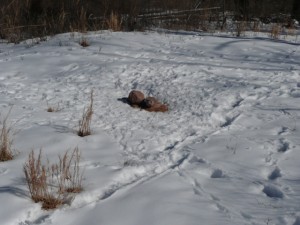
Deer tracks in snow near a Trophy Rock
The quantity and number of locations with quality food is decreasing with the winter temperatures, unless supplemental feed is used on the property you hunt. Therefore identifying the preferred feeding location for deer is becoming easier. That’s great news for hunters!
However, it doesn’t mean hunting is becoming easier. Hunting season has been in effect throughout most of the whitetails’ range for several months. Mature deer are very conditioned to avoiding hunters at this stage of the season. Therefore, identifying the preferred food source is only part of challenge.
Chasing deer that are experienced at avoiding hunters is no easy task. The leaves are mostly off hardwood trees so stands that offered great cover a month ago now leave the hunter wide open.
Good camo, especially on the face and hands (the parts of a hunter that move the most when they are in a stand) is a must. Remember that deer see movement much better than they see cover.
Deer may be conditioned to avoid some fields during daylight due to the amount of hunting in that location already during the season. If that’s the case, select a stand location between the bedding area and the field. Better yet, if practical avoid hunting some plots until the late season. Let deer become conditioned to feeding in an area without being disturbed by hunters. Those are dream locations during the late season. I often use an electric fence to protect small plots until the late season. These plots would have been totally consumed if not protected by the fence.
Finally, with the colder the temperatures, the more deer need to feed to maintain their body temperature. Colder temperatures usually result in deer feeding during daylight hours. Mature bucks will be feeding in the plots that haven’t had much hunting pressure and I plan on being there. The late season usually offers some of the most predictable deer activity throughout the entire season.
I ordered some heated insoles for my boots today. I’m hoping for some very cold days during the late hunting season. It’s worth getting a little cold to hunt mature bucks that have a predictable movement pattern to specific location.
Growing Deer together,
Grant



